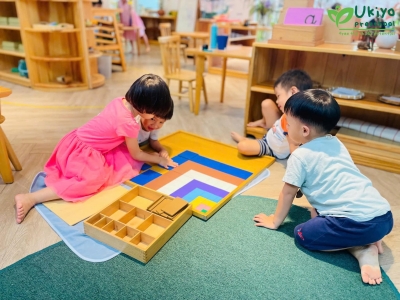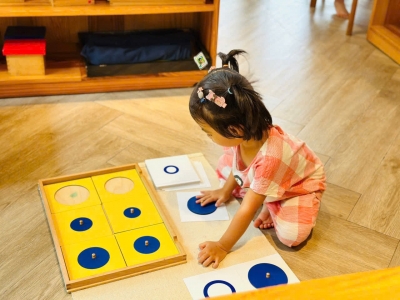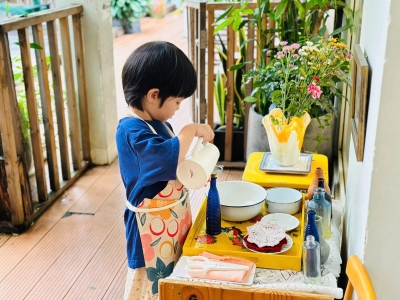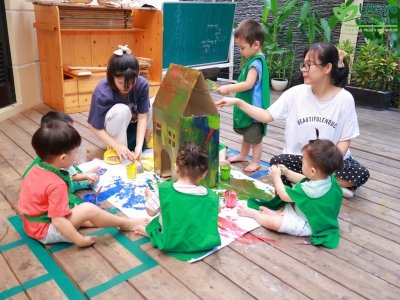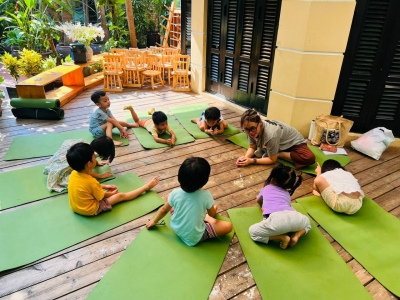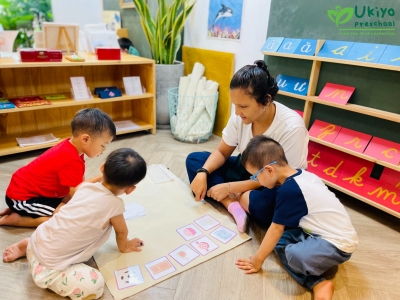THE ORIGINS OF CHILDREN TENDENCIES: EXPLORATION, ORIENTATION AND ORDER
Montessori regarded exploration as a fundamental behavior of human beings from their beginnings. The first human beings had to search their unknown surrounding environment in order to find the sources for meeting their primary needs. Exploration then was the predominant force in human activity from the earliest days, bringing with it, when successful, the exhilaration of achievement. Even today when we set out to explore the challenge of the unknown, the joy of pre-historic human beings still comes to us.
Children begin their exploration of the earth’s environment from the first moment after birth. They are immediately bombarded with light, sound, smell, and touch of skin. Montessori described this
initial experience of the child as a “second birth” because it represents the beginning of a second embryological life—this time outside the womb. Even if they appear to be doing nothing, motionless infants are exploring in their cribs. It is an invisible exploration of hearing, looking, and feeling air and touch upon the skin. These impressions are so fundamental that they shape the development of the child’s brain. Within the first fifteen days after birth, an entire neurological network has formed. The infant, as explorer, has “gone out” into the environment, taken it in and come back a different individual, just as all explorers’ search and find knowledge and bring it back for their use.
The human need to know enables the child to finish his or her own body and brain and to become a human being of the time and place where he or she is born. The child’s goal then in exploration is twofold: to finish his or her own body through the development of the brain via exploration of the environment and to adapt to the group in which he or she is born. The great pull toward this twofold goal is implicit in Montessori’s conception of human tendencies. One usage of the Italian word, tendere, relates to the archer’s pulling of the cord of a bow with an arrow aimed directly at its target. This image of power and singleness of purpose, as represented by the pulled bow and poised arrow, gives a clear indication of the driving force which Montessori attributes to human tendencies in directing human behavior.
As we shall see, Montessori education at each succeeding level is predicated upon the basic human urge to explore. The environments for children under six years old o er a feast of exploration for children, not of a fantasy world as in many preschools and day-care centers but the world of reality that the first human beings set out to explore. The elementary program, secondary level, and plan for the university continue this exploration of the real world, extending it beyond the classroom into the community and, eventually, to the world at large.
As those first human beings explored farther and farther from their point of origin, they had to have some means for returning to their starting place. Only in this way could they have achieved the freedom and independence to move about. We must then have a tendency to put ourselves in relation to our environment, to make a pattern of it in our minds. We have to be able to review this mental map: to make an order of it in our minds. We have to know where to start, where to go next, and where to finish. In order for the first human beings to find their way in their explorations, orientation and order had to have been tendencies of their behavior.
The moment that the child receives impressions, he or she must hold them within the brain in an accessible pattern. There is, then, a tendency to order these impressions within the mind for future use. This personal classification of impressions is limited, however, if it does not coincide with those relationships that the culture accepts. Montessori devised materials that assist the child in understanding this broader classification of impressions. By their means, the child is given access to the scientific world. Sensorial materials assist the child in establishing an understanding of comparative relationships in size, weight, length, and volume, for example. This is not their first
time that the child handles objects of different size or weight. It is the extension of dealing with the relationships among objects, however, that is important for cultural adaptation. Thus, the child
learns to distinguish: heavy, heavier, heaviest or thin, thinner, thinnest. The child becomes a member of his or her society, possessing the key to interacting with all its scientific knowledge. From a cognitive point of view, exploration is no longer purely sensorial but is extended to a higher level.
Order and orientation are facilitated in the Montessori classroom by a well-structured environment, the sequencing of materials, and the consistency of educational approach. Each material has its own place in the room where it can always be found when it is not in use. This outward order is dependent upon an internal one related to the practical development of moral standards. In a communal situation, for example, we put objects for use back in the place and condition we found them out of respect for others. Lectures about such behavior are of little use to human beings; these are experiences we must live at an early age.
The children are introduced to the materials in a Montessori environment in an orderly sequence and logical progression. Sequence of materials gives the children an experience of orientation in cause and effect. Eighteen-month-olds learn that, when washing, they wet their hands first, then use soap, rinse, and dry with the towel and not the other way around. From logical progression in their activities, they develop their capacity for logical and orderly thought. Enhancement of the children’s natural tendencies to order and orientation in the Montessori environment enables them to feel great confidence there. This is a place that they can manage and, therefore, they feel safe. This sense of security is not just the result of having a loving teacher upon whom they can depend; it is the natural outcome of the children being in a place where they can trust their own powers. It is psychological security, engendered in part by a properly structured environment, which gives children the impulse to try harder to face the unknown, including the unpleasant facts of life. The goal is to help children use their human energies to deal with the failures and disappointments of their lives and not to be destroyed by them.
Montessori today: a comprehensive approach to education from birth to adulthood / by Paula Polk Lillard. – Ukiyo Team translated
Others



